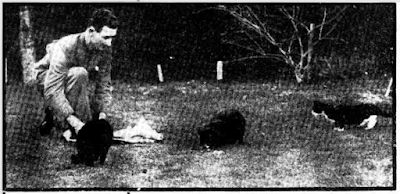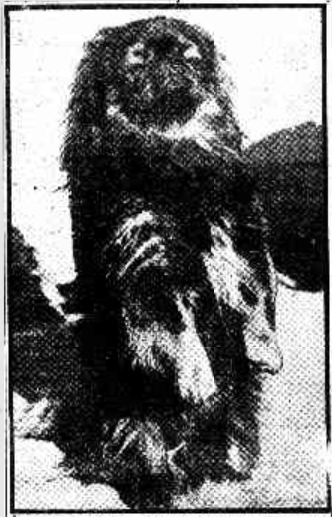Norman Connel Superintendent Shenton Park Dogs' Refuge Home (1950).
Norman Connel was the Superintendent of the Shenton Park Dogs' Refuge Home for many years. He came to Australia from Toronto in Canada in 1941 where he was an experienced breeder and judge of dogs.
After the war Norman came to Western Australia and obtained the position as Superintendent at the Dogs Refuge Home in Shenton Park which had been closed for five years during the war. He helped established a world class facility in caring for dogs which continues today (Daily News, 30 August, 1947).
Norman shared many stories about the dogs he came across in the newspapers. Some of those are copied below.
Noman died in 1950 in Royal Perth Hospital.
The stories and photographs are from Trove, the database of the National Library of Australia. No copyright infringement intended.
Geraldton Guardian, 20 June, 1950.
Death of Keen Dog Lover
Refuge Home Superintendent DEVOTION TO DUTY Perth, This Afternoon.
Described by experts as one of the finest judges in the world of all breeds of dogs, the superintendent of the dogs Refuge Home (Norman McConnel), aged seventy-two years, died at the Royal Perth Hospital yesterday.
He came to Australia from Canada in 1941 as the chief dog judge at the Melbourne Royal Show. The war changed his plans of returning immediately to America and he started work in ammunition factory. In 1947 he came to Western Australia and re-opened the Dogs' Refuge Home at Shenton Park, making it one of the chief animal welfare centres in Australia. A true animal lover, Mr. McConnel unsparingly devoted his time to the care of the dogs, being often on duty for the seven days of the week.
Daily News, 23 March 1950
Unwanted Foxie May Be Australia's Top Dog
Superintendent Norman McConnel of the Shenton Park Dogs' Refuge Home left Perth last night on a mission which he hopes will bring prestige to West Australian dog-lovers — and fame to a dog which he first saw as an unwanted, dejected pup.
He boarded yesterday's Westland with a 14 months old, wire-haired fox-terrier to enter in the Sydney Royal Show which opens next month. He will enter the terrier in the open class, is confident that it will either take the prize as open-class champion or be among the place getters.
If Mr. McConnel is successful, the terrier's story may well go down in dog history as that of a canine 'Cinderella.' Six months ago the terrier was left at the Dogs' Refuge Home. It was a pathetic sight, obviously unhappy and in poor condition.
Its owner left a guinea to help' pay for its keep as a stray at the home. But in. the terrier the practised eye of Mr. McConnel saw the makings of a champion. Examination of the dog and later inquiries revealed three crosses of the best class of wire-haired terrier seen in the U.S. for many years.

Daily News, 3 October 1949,
Manager Of Dog's Home,
Superintendent N. McConnel of the Shenton Park Dogs' Refuge Home has entered a 'Cinderella' dog for the Royal Show. The dog, a three-year-old cocker spaniel, was brought, unwanted to the home about a month ago. Despite its lean and rough condition — 'it looked like an angora goat'— Mr. McConnel recognised the spaniel's good breeding.
He bought the dog for himself, and has registered it under his own name for the show. Although he has had little time to get it ready, it has already made rapid improvement under his skilled care. 'I haven't had the opportunity to prepare it to the stage where it could be expected to get a first prize, but it will not run last,' he said today.
The spaniel is only one of many unwanted dogs of good breeding brought to the home in recent years. 'Many people think we have only mongrels here. We do get a lot — this place was built for the unwanted dogs,' he said.
An international dog judge, Mr. McConnel has won many prizes in North America for his own entrants. Soon after he arrived in WA to take his present position with the Dogs' Refuge Home in 1946, he won a first prize at the Royal Show with a dog he brought with him from Victoria.

Daily News, 26 December 1949.
At Shenton Park Dogs' Refuge Home, Christmas Day began with 90 'boarders,' there for the holidays. It ended with 91, because the pekinese here had one tiny pup. And to mark the occasion, the new arrival was christened 'Santa.'

FORCED TO SHARE his bedroom with one of his restless charges because it refused to stop barking when left outside, Shenton Park dogs' home superintendent McConnel is shown here nursing the culprit on his knee.
Daily News, 8 January 1949, page 10
DOGS LEAD PERTH MAN A DOG'S LIFE
Because of the incessant barking of the dogs in his care, Superintendent McConnel of the Shenton Park Dogs' Refuge Home was not able to sleep for four consecutive nights.
He thought the matter over and eventually established peace and quietness in the home by putting one particularly restless dog to sleep in a crate in his bedroom. Reason for the excessive night barking at the home was the overcrowding due to so many people being away on holidays.
'You can't blame the dogs,' Mr. McConnel said. 'They become very attached to their masters, and when placed in a strange home with a lot of strange dog companions they naturally start to yelp at night.' Starts 130 The dog which he took to his room to sleep was a crossbreed cocker spaniel — Australian terrier 'with a howl that would wake the dead.' The howling of this one dog was sufficient to start the entire 130 dogs yelping. Special treatment was required.
To keep peace, it was necessary to sort all the dogs out and group them suitably in the pens. When placed in the 'bed-room pen' the lone dog soon settled down and slept peacefully. So did the dogs in the outside pens.
Daily News, 26 May 1948.
Many Want To Adopt Stray Collie
Since a stray collie dog was pictured in yesterday's Daily News, the Dogs' Refuge Home at Shenton Park has been besieged with requests to 'adopt' him.
But so far the owner has not claimed him. The collie attached himself affectionately to a policeman on point duty yesterday, refused to leave.
So an RSPCA officer, who was notified, collected the dog in a van and took him to the Dogs' Refuge Home.
'Never Forget' 'I. will never forget that dog as long as I live,' said the home's superintendent Norman McConnel today. 'I was answering telephone calls till after 10 o'clock last night from people who would like the dog.'
By 10 a.m. today the dog's home had had 36 calls, the RSPCA had had one, and a number of people had approached the Daily News about the collie. If the owner does not claim the dog, first priority will be given to a request from an old man who is still mourning the loss of his collie which died after 17 years with him. A man who looks after a dog as long as that deserves consideration in this case,' said Mr. McConnel.
























